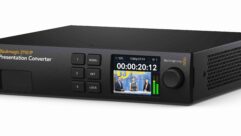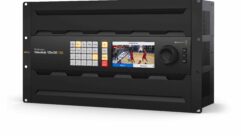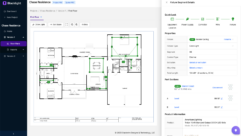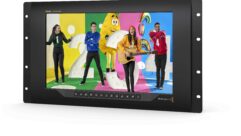Do you truss me?When you have thousands of pounds of equipment hanging over your head, this is no time for sloppy design and slapdash maintenance.
Dec 20, 1996 12:00 PM,
Ian ColesColes is president of Total Fabrications, Ventura, CA.
The concept of the box truss has been around for many years; it is an efficient use of materials to create high-strength, low-weight structures. Box trusses can be seen just about anywhere, from freeway signs to the Eiffel tower.
Within our industry, where weight, flexibility and handling are of primary importance, aluminum has become the material of choice because of its inherent weight-to-strength properties. In the United States, aluminum truss is primarily made from a 6061-T6 alloy, a high-strength, aircraft-grade alloy with good weldable properties. The European manufacturers use the equivalent 6082 alloy.
Truss systems for the entertainment industry primarily evolved out of the desire for ever-larger lighting systems in the 1970s. During that period, the truss became synonymous with the rock-and-roll look.
Twenty years later, the range of aluminum truss and its applications is enormous. The truss systems of today are like huge erector sets, infinitely reconfigureable and totally modular, used not only as a structural platform for flying lights and sound but also for trade show structures, large architectural pieces, stage roof covers and any environment in which a temporary structure is required. And as an aside, you should note that most outdoor applications are subject to an entirely different set of conditions than an indoor environment, most critically wind loads; therefore, all outdoor truss configurations must be approved by a structural engineer.
Types of trussA truss comes in different load-bearing formats. The four most common formats are manufactured as industry standard: a light-duty 12″—12″ (305 mm — 305 mm) unit, a 201/2″— 201/2″ (521 mm) structure for medium duty, a 201/2″— 30″ (521 mm — 762 mm) truss for heavy duty, and a 30″— 26″ (762 mm — 660 mm) prerigged unit designed to travel with lighting fixtures inside the truss. These trusses are generally fastened together using high-strength steel bolts through gusset plates.
However, because proprietary styles of truss are offering more competition in the marketplace, some manufacturers are being encouraged to innovate. Total Fabrications, for instance, now offers a complete range of trusses incorporating its patented turn buckle connector (see Figure 1), which allows the connection to be made directly between the main chords of the truss without the tolerance problems usually encountered with chord connection trusses. A chord connection can increase the truss capacity by as much as a factor of two. Trusses are generally available in a variety of standard lengths and accessories, but custom angles, lengths or curved sections can be manufactured to order.
A live-show environment typically requires use of a truss in two different ways. The most common use is to fly a truss from the existing building structure by way of chain hoists, which involves riggers climbing into the building roof and attaching rigging points for the chain hoists to hang from. The truss allows the whole show to be supported from the same structural configuration night after night, city after city. This gives the show a consistency not only of appearance but also in the daily rig preparation.
The second way to use a truss is to support it by way of a ground support system. (See Figure 2.) This method is used when no structure exists from which to fly the rig, when the building structure is not strong enough to support the show or when the building structure is inaccessible to riggers. Ground support systems are typically a series of truss towers with self-climbing sleeve blocks, which are corner blocks intersecting between the perpendicular truss spans the tower passes through. Wheels inside the sleeve block running up and down the vertical chords of the tower truss make the mechanical connection between the horizontal truss grid and the tower.
Safe trussingThe load-bearing capability of any truss depends on many things, including the type of material it is made from, the quality of the workmanship, the overall size of the truss and the connection between sections. All of these things should be considered in truss design; one can be compromised for another, except for workmanship. All welders involved in the manufacture of trusses should carry certification in structural aluminum welding.
When considering which truss to use for a particular application, you must consider many things. The most important is how much weight will be distributed to how many points on how long of a span. All reputable truss manufacturers publish load tables for each type of truss they manufacture for simple span applications. You should never exceed the manufacturer’s maximum spans or allowable loads.
If you have any doubt about the application for the truss, contact the manufacturer. Many manufacturers affix labels with the basic load information and relevant telephone numbers for precisely this purpose. When purchasing a truss for specific applications, try to get input from the manufacturer. All reputable manufacturers either have professional engineers on their staff or retain a professional engineering company, and they should be happy to consult on any situation where the standard load tables are not sufficient. Some situations require full engineering reports to ascertain structural adequacy of particular configurations.
The connection of the lifting equipment, typically chain hoists, to the truss is generally achieved by one of three methods:* Polyester round slings are commonly used in most temporary situations. Take care in determining the load rating for the sling; they not only come in different ratings, but their ratings can change substantially depending on the connection format, whether it be basket or choker, and the angle at which the sling meets the hardware. Check with the manufacturer for further information. Alternatively, rigging points can be manufactured into the truss, which is ideal for permanent installations, or a clamp-on rigging point can be used in situations where you move the points for different setups. I recommend that when the rig reaches its final location, additional steel safety cables are used as a back-up in case of an equipment failure. In case of a fire, the round slings would most likely be the first thing to fail.
Safety when using a truss is the primary concern; it cannot be stressed enough. Make sure the manufacturer you choose regularly performs adequate engineering on the product and that only certified welders have been used in the manufacturing process. Do not assume that a truss that looks the same is the same. Find out whether the manufacturer is acting responsibly and whether the manufacturer carries product liability insurance. Never use a truss if you do not have published engineering specifications for it.
The contractor also has a responsibility to operate the equipment safely. Always use professional and adequately trained and experienced personnel, make one person directly responsible for the safe operation of the equipment, and assume nothing. If you have any doubt regarding the application of the truss, be sure to get advice from the manufacturer.
For the long haulA truss is an expensive piece of equipment with a considerable life span if it is not abused; it can also be rendered useless on its first job if it is abused. A truss should be visually inspected each time it is used for any sign of damage. Pay particular attention to welded joints for any signs of stress fractures. If you see any distortion from its original shape – bent members, serious abrasion, indentations from clamps or any other visible sign of damage – the truss should be removed from service and inspected by the manufacturer, a reputable inspection company or an engineer.
Establish a regular truss maintenance schedule; the manufacturer can tell you specific procedures and how often to perform them. Never use a piece of truss that has previously been overloaded. If a truss span has been overloaded, all sections in that span should immediately be condemned whether it shows signs of stress or not.
Any modification or repair to a piece of truss carried out by someone other than the original manufacturer may void any of the manufacturer’s liability or warranty. When buying used trusses, remember that an overloaded truss may show no wear, and you have no guarantee of the product’s history.
Although the concept of using trusses is relatively simple, don’t forget the high level of responsibility the manufacturer and end user have to the people who will be nearby when the job is done. If this makes you feel some degree of anxiety, then I have achieved my goal. We have a generally safe industry; let’s keep it that way. And remember, if in doubt, call the manufacturer and ask.










